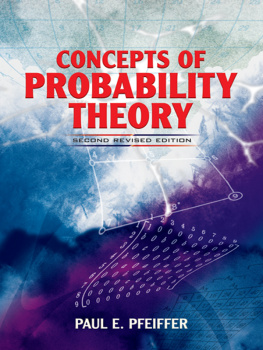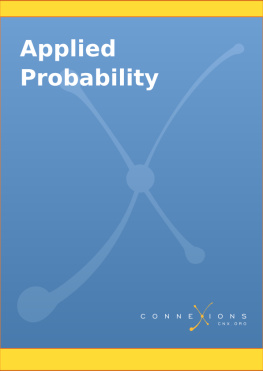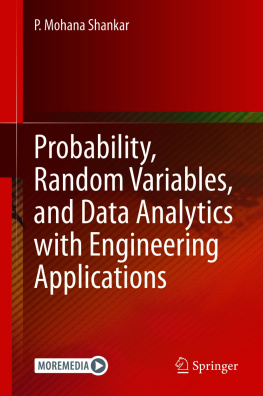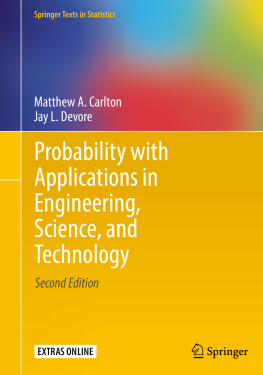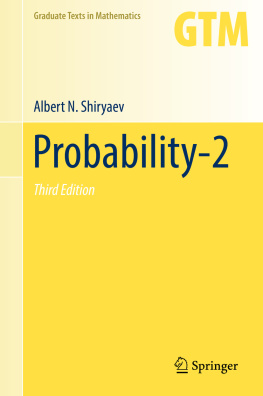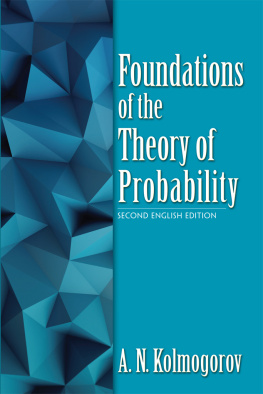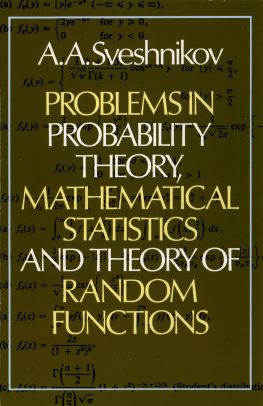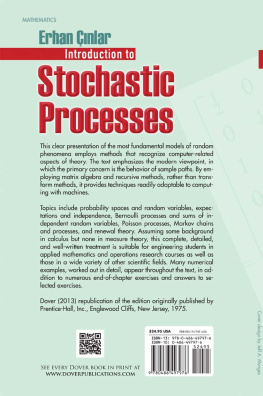to Mamma and Daddy
Who contributed to this book
by teaching me that hard work can be
satisfying if the task is worthwhile.
Copyright 1965 by Paul E. Pfeiffer.
Copyright 1978 by Paul E. Pfeiffer.
All rights reserved.
Bibliographical Note
This Dover edition, first published in 1978, is an unabridged republication of the work originally published by McGraw-Hill Book Company, New York, in 1965. This Dover edition has been extensively revised and updated by the author.
Library of Congress Catalog Card Number: 78-53757
International Standard Book Number
ISBN 13: 978-0-486-63677-1
ISBN 10: 0-486-63677-1
Manufactured in the United States by Courier Corporation
63677107
www.doverpublications.com
My purpose in writing this book is to provide for students of science, engineering, and mathematics a course at the junior or senior level which lays a firm theoretical foundation for the application of probability theory to physical and other real-world problems. Mastery of the material presented should provide an excellent background for further study in such rapidly developing areas as statistical decision theory, reliability theory, dynamic programming, statistical game theory, coding and information theory, communication and control in the presence of noise, etc., as well as in classical sampling statistics.
My teaching experience has shown that students of engineering and science can master the essential features of a precise mathematical model in a way that clarifies their thinking and extends their ability to make significant applications of the theory. While the ultimate aim of the development in this book is the application of probability theory to problems of practical import and interest, the central task undertaken is an exposition of the basic concepts of probability theory, including a substantial introduction to the idea of a random process. Rather than provide a treatise on applications and techniques, I have attempted to provide a clear development of the fundamental concepts and theoretical perspectives which guide the formulation of problems and the discovery of methods of solution. Considerable attention is given to the task of translating real-world problems into the precise concepts of the model, so that the problem is stated unambiguously and may be attacked with all the resources provided by the mathematical theory as well as physical insight.
The rich theory of probability may be constructed on the essentially simple conceptual framework of that mathematical model generally known as the Kolmogorov model. The central features of this model may be grasped with the aid of certain graphical, mechanical, and notational representations which facilitate the formulation and visualization of concepts and relationships. Highly sophisticated techniques are seen as the means of performing conceptually simple tasks. The whole theory is formulated in a way that makes contact with both the literature of applications and the literature on pure mathematics. At many points I have borrowed specifically and explicitly from one or the other; the resulting treatment points the way to extend such use of the vast reservoir of knowledge in this important and rapidly growing field.
In introducing the basic model, I have appealed to the notion of probability as an idealization of the concept of the relative frequency of occurrence of an event in a large number of repeated trials. In most places, the primary interpretation of probability has been in terms of this familiar concept. I have also made considerable use of the idea that probability indicates the uncertainty regarding the outcome of a trial before the result is known. Various thinkers are currently advocating other approaches to formulating the mathematical model, and hence to interpreting its features. These alternative ways of developing and interpreting the model do not alter its character or the strategies and techniques for dealing with it. They do serve to increase confidence in the usefulness and naturalness of the model and to point to the desirability of achieving a mastery of the theory based upon it.
The background assumed in the book is provided in the freshman and sophomore mathematics courses in many universities. A knowledge of limits, differentiation, and integration is essential. Some acquaintance with the rudiments of set theory is assumed in the text, but an Appendix provides a brief treatment of the necessary material to aid the student who does not have the required background. Many students from the high schools offering instruction in the so-called new mathematics will be familiar with most of the material on sets before entering the university. Although some applications are made to physical problems, very little technical background is needed to understand these applications. The book should be suitable for a course offered in an engineering or science department, or for a course offered by a department of mathematics for students of engineering or science. The practicing engineer or scientist whose formal education did not provide a satisfactory course in probability theory should be able to use the book for self-study.
It has been my personal experience, as well as my observation of others, that success in dealing with abstract systems rests in large part on the ability to find concrete mental images and constructs which serve as aids in visualizing, remembering, and relating the abstract concepts and ideas. This being so, success in teaching abstract systems depends in similar measure on making explicit use of the most satisfactory images, diagrams and other conceptual aids in the act of communicating ideas.
The literature on probabilityboth works on pure mathematics and on practical applicationscontains a number of such aids to clear thinking, but these aids have not always been exploited fully and efficiently. I can lay little claim to originality in the sense of novelty of ideas or results. Yet I believe the synthesis presented in this book, with its systematic exploitation of several ideas and techniques which ordinarily play only a marginal role in the literature known to me, provides an approach to probability theory which has some definite pedagogical advantages.
Among the features of this presentation which may deserve mention are:
1. A full exploitation of the concept of probability as mass; in particular, the idea that a random variable produces a point-by-point mass transfer from the basic probability space is introduced and utilized in a manner that has proved helpful.
2. Exploitation of minterm maps, minterm expansions, binary designators, and other notions and techniques from the theory of switching, or logic, networks as an aid to systematizing the handling of compound events.
3. Use of the indicator function for events (sets) to provide analytical expressions for discrete-valued random variables.
4. Development of the basic ideas of integration on an abstract space to give unity to the various expressions for mathematical expectation. The mass picture is exploited here in a very significant way to make these ideas comprehensible.
5. Development of a calculus of mathematical expectations which simplifies many arguments that are otherwise burdened with unnecessary details.
None of these ideas or approaches is new. Some have been utilized to good advantage in the literature. What may be claimed is that the systematic exploitation in the manner of this book has provided a treatment of the topic that seems to communicate to my students in a way that no other treatment with which I am familiar has been able to do. This work is written in the hope that this treatment may be equally helpful to others who are seeking a more adequate grasp of this fascinating and powerful subject.

